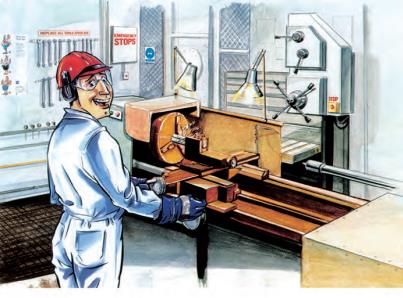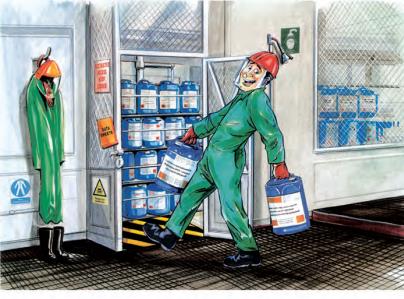Wear Your Goggles!
Eye injuries are commonplace at sea – the majority are preventable. In this article we provide some general advice on preventing eye injuries and focus on the eye protection necessary when carrying out work associated with painting.
Causes of Eye Injuries
The importance of seafarers wearing appropriate eye protection when engaged in tasks which expose eyes to the risk of injury cannot be over-emphasised.
The main causes of eye injury to seafarers are:
- exposure to particles and foreign bodies;
- exposure to chemicals;
- exposure to ultraviolet rays (during electric welding);
- and exposure to infra-red rays (during gas welding).
A wide variety of eye protection is available and designed to international standard specification to protect against these different hazards. Seafarers must be supplied with the appropriate eye protection for the task in question. The seafarer must use it in accordance with the manufacturer’s instructions. Many eye injuries occur when seafarers do not wear the eye protection provided. If you do this you are risking your sight.
Where and When to Wear
Suitable goggles and eye protection should be worn when or wherever there is a risk of eye injury. They should always be worn when working with or nearby to:
- Operating machine tools.
- Handling shipboard chemicals or paint using cleaning agents.
- Using welding or burning equipment.
- Using pressure washing equipment.
- Anchoring.
- Operating shot-blasting equipment, needle guns or chipping hammers.
- Using grinding equipment.
- There is any risk of an eye injury.
Eye Protection when Painting
Surface Preparation
Eye protection is essential when preparing any surface, for example by brushing or chipping. This is to ensure that foreign bodies do not get into and injure the eye. Painted surfaces should be rubbed down wet in order to reduce dust and a dust mask should be worn to prevent inhalation of potentially toxic dust. If the surface to be rubbed down contains or may contain lead then methods that do not create dust should be adopted. Sanding or abrasive blasting should be avoided and lead based paints must never be burned off as the resulting vapours contain highly toxic metallic lead.
 Rust remover which may be used in the preparation of a surface is a strong acid. Rust remover should not be allowed to come into contact with unprotected skin and eye protection must be worn to guard against splashes.
Rust remover which may be used in the preparation of a surface is a strong acid. Rust remover should not be allowed to come into contact with unprotected skin and eye protection must be worn to guard against splashes.
In a recent incident a seafarer suffered an eye injury caused by a small speck entering his eye whilst he was carrying out surface chipping to prepare the surface for painting. Although the seafarer was wearing the safety goggles provided, it is likely that a tiny particle of paint gained access into his chipping goggles via the small ventilation holes in the side of the goggles. The particle was then rubbed into his eye when he wiped away perspiration from his face. Further rubbing by the seafarer in an attempt to relieve discomfort caused additional injury to his eye. Although in this instance the seafarer’s eye did not suffer permanent damage and he made a full recovery, the example illustrates the importance of proper eye cleansing procedures.
When goggles are used for the purpose of reducing exposure to dust and tiny particles it may be appropriate to use a light filter cloth to prevent particles from entering goggles via the small breather/ventilation holes.
Surface Contamination
The paint itself may not be toxic but it may be covered with dust or particles that are chemical toxins or irritants. As an example chemical contamination by hydraulic fluid of the paint being rubbed down could cause a paint speck to pose a serious threat to sight.
Spray Painting
There are several types of paint spraying equipment in use on ships but airless spray painting equipment is particularly hazardous. Paint is ejected from this equipment at very high pressure and the spray can penetrate the skin or cause serious eye injury. Under no circumstances should the spray be allowed to come into contact with the face or any unprotected skin. Personal protective equipment comprising a combination suit, gloves and cloth hood and appropriate eye protection in the form of goggles or a visor should be worn whenever crew are carrying out paint spraying. Paints containing lead, mercury or similarly toxic compounds should never be sprayed on interiors and if necessary, a suitable respirator should be worn in accordance with the nature of the paint being used. In exceptional circumstances it may be necessary to use breathing apparatus during spray painting operations.
Proper entry into enclosed spaces procedures should always be followed whilst any painintg is taking place and until paint has dried. Seafarers should always be aware of the nearest emergency eye wash stand available before commencing any painting operations.
Loss Prevention
- Wear appropriate eye protection!
- Consider surface contamination.
- Know the location of the nearest eyewash.
- Seek medical advice early.

 , you have now set your site language to English. If you'd like to change your language preference again, simply click on one of the other flags.
, you have now set your site language to English. If you'd like to change your language preference again, simply click on one of the other flags. を選択して頂くと、言語設定が日本語に切り替わります。設定変更後は以下の機能が利用可能です。
を選択して頂くと、言語設定が日本語に切り替わります。設定変更後は以下の機能が利用可能です。
 ,可将网站语言设置为中文。这能帮助您:
,可将网站语言设置为中文。这能帮助您:


